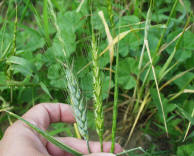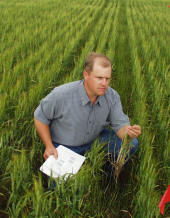Points to Remember
- Jointed goatgrass closely resembles the life cycle of winter wheat.
- Spikelets (joints) can germinate in the fall or spring and produce viable seed.
- JGG seed can remain viable for five or more years.
- Seed will remain viable longer in reduced rainfall areas.
Jointed goatgrass closely mimics the life cycle of winter wheat. Seeds germinate in the fall, plants overwinter, and resume growth in the spring. Although seeds typically germinate in the fall, jointed goatgrass can also germinate during March and April and still produce viable seed. Jointed goatgrass matures and shatters seed on the soil surface during, or up to three weeks before wheat harvest. Spring germinating plants usually mature and produce seed later than fall germinating plants.
Scientists in Washington recently discovered that jointed goatgrass can produce seed with no vernalization (overwintering or chilling) event. It was not clear whether a population of jointed goatgrass could become a serious problem in spring cereals as it is in winter wheat because of spring germinating plants. However, rotating only to a spring cereal may not completely eliminate jointed goatgrass seed production in that crop.
Approximately 80% of the seed at this depth will germinate within three years. Some seed can emerge from 2 to 3 inches, but very few will emerge from more than 4 inches. The optimum temperature for germination is 68°F and the optimum range is 50° to 86°F. Some germination may occur as low as 36°F and as high as 104°F. Seed can remain viable for five years or more, especially when deeply buried.

Seed will typically decay faster in a region with higher precipitation. A study in the Pacific Northwest showed seed remained viable for over five years in a 10-inch rainfall area compared to less than three years in a 22-inch rainfall area. In addition, most jointed goatgrass seed will germinate from a depth of 0 to 2 inches in soil.
